Real-Time Visibility: How IoT in Inventory Management Enhances Accuracy
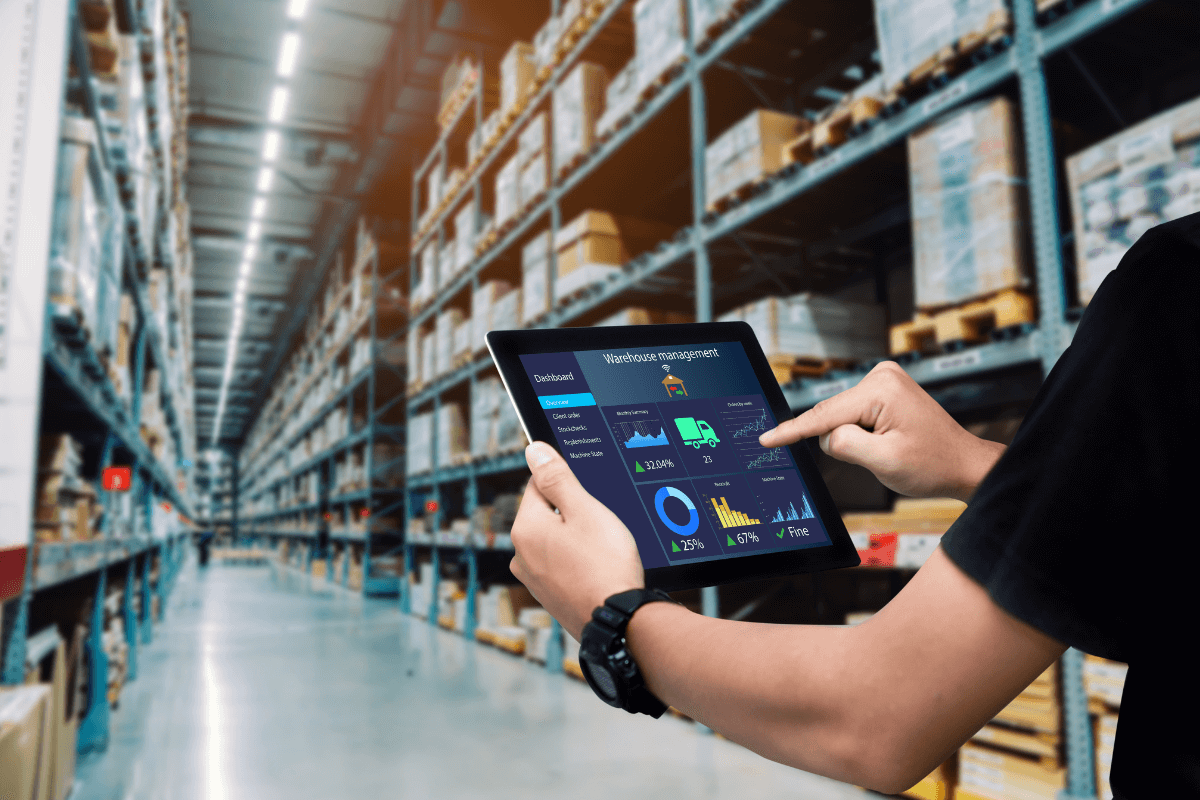
Does your current inventory tracking system complicate the management of your supply chain or, even worse, hold you back with inaccuracies and lost profits? Or maybe you do inventory counts manually and are tired of endless searches for misplaced items? Can we be totally honest with you? It’s time to rethink your strategy. There are different ways to fix that, but IoT in inventory management is a complete game changer for every business owner who finds themselves in a similar situation.
Wouldn’t it be great if every item in your inventory was accounted for with pinpoint accuracy, the stock levels were always ideal, and your supply chain ran smoothly? With IoT, it is possible and achievable. So, what does it take to reach these gains, and what do IoT software development services have to offer? In this guide, you’ll find all the relevant information about the IoT concept, its advantages, challenges, ways to implement IoT inventory management solutions, and more.
IoT in Inventory Management: Overview
Although the Internet of Things technology is quite popular nowadays, and there is much talk about its potential, let’s be clear on what IoT actually is.
What is IoT?
The Internet of Things (IoT) is an ever-growing network of devices that can talk to each other and exchange data over the Internet due to built-in sensors and software. IoT architecture typically involves sensors that collect data, connectivity that transfers the data, edge devices that process data locally, and cloud systems that store and analyze the information.
IoT devices are so widespread that we use them everywhere. IoT-based coffee makers, for example, can automatically reorder beans when supplies run low, a thermostat learns your preferences and adjusts the temperature accordingly, and a car sends diagnostic data to a mechanic before a potential issue arises.
If we take a wider look at IoT devices, they range from simple temperature sensors to complex industrial machines. So, it’s natural that they found hundreds of applications across various industries, including:
- Manufacturing: Sensors can monitor production lines, track equipment performance, and optimize energy usage.
- Smart cities: Street lighting, smart transportation systems, and connected waste management are just some examples of IoT in action.
- Healthcare: Wearable devices track vital signs, while connected medical devices can transmit data to remote healthcare providers.
- Retail: IoT helps optimize inventory levels, streamline supply chain operations, and enhance in-store customer engagement with personalized offers and smart shelves.
The Role of IoT in Inventory Management
Now, let’s talk inventory management. Inventory management is the process of overseeing stock levels to ensure product availability and minimize storage costs. Traditionally, it’s performed manually and involves physical counts and barcode scanning, which are prone to errors and inefficiencies. For anyone who’s ever tried to keep track of products in a warehouse or a store in a traditional way, you know it can be a logistical nightmare.
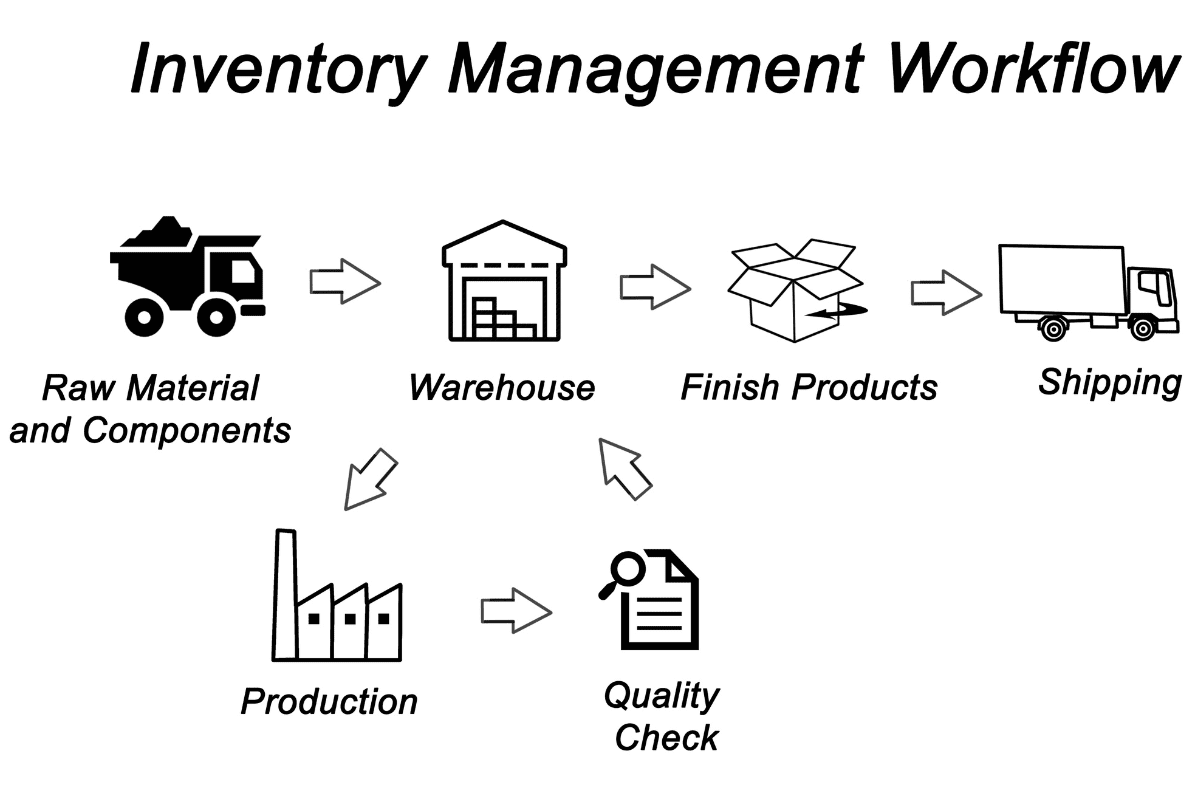
So, how is IoT used in inventory management, and what perks does it offer? By embedding sensors in products, smart shelves, and placing cameras throughout a warehouse, IoT easily integrates with inventory management systems. These inventory sensors continuously collect data on:
- Location: Monitor the inventory movements across the entire supply chain.
- Quantity: Maintain accurate stock levels to prevent stockouts and overstocking.
- Condition: Monitor temperature, humidity, or other environmental factors for items that are perishable or require delicate handling.
The information collected on goods is then sent to a central system, where it’s processed and used to make decisions.
Key IoT Technologies in Inventory Management
As you could guess, an IoT management system consists of several components that make the whole thing run. Here’s an overview of IoT technology in inventory management and its major elements:
- RFID Tags
RFID (Radio Frequency Identification) tags are tiny stickers with radio waves that act like unique digital codes for your inventory. They contain a microchip and antenna to be able to communicate with RFID readers, which are usually placed throughout a warehouse or store. When the tagged item passes by a reader, the reader picks up the unique code from the tag and updates the smart inventory system with the item’s location and status. You have an up-to-the-minute overview of your entire inventory at the click of a button.

- Smart Sensors
Sensors can be described as the eyes and ears of the IoT inventory management system due to the function they perform. They monitor and report on the warehouse’s environmental conditions (temperature, humidity levels, light exposure, pressure, vibration, etc.) to help keep inventory safe and in good condition. Let’s suggest you’re running a warehouse storing perishable goods. A sudden spike in temperature could spoil an entire batch before anyone notices. But with smart sensors in place, you’ll receive instant alerts if conditions deviate from the acceptable range so you can take immediate action. While considering implementing these technologies, it’s crucial to understand the cost of IoT sensors, as this investment can significantly impact your overall budget.
- GPS and Beacon Technology
GPS technology, familiar to anyone who’s used a smartphone to find directions, can also be applied within large-scale smart inventory management. You may argue that the GPS signal is weak indoors and, therefore, not reliable for tracking inventory within a warehouse. Yet, when combined with a beacon technology, it creates a powerful hybrid solution. Beacons are compact transmitters that use low-energy Bluetooth signals to talk to nearby devices. As items equipped with GPS and beacon receivers move through the warehouse, their exact locations can be easily tracked. Just imagine how much time and cost savings you can achieve when you know exactly where each item is positioned.
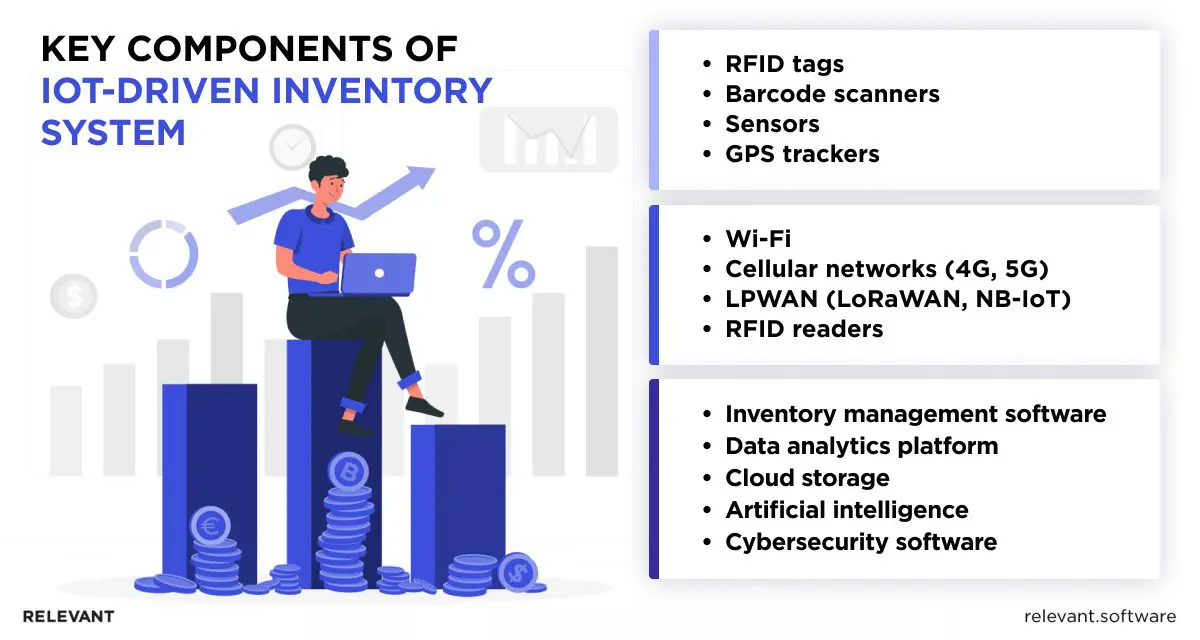
Benefits of Real-Time Visibility in Inventory Management
According to Fortune Business Insights, the global market for IoT in warehouse management is expected to surge from $12.13 billion in 2023 to an eye-opening $28.79 billion by 2030. There is no doubt that IoT in inventory management offers a number of lucrative advantages. Which ones?
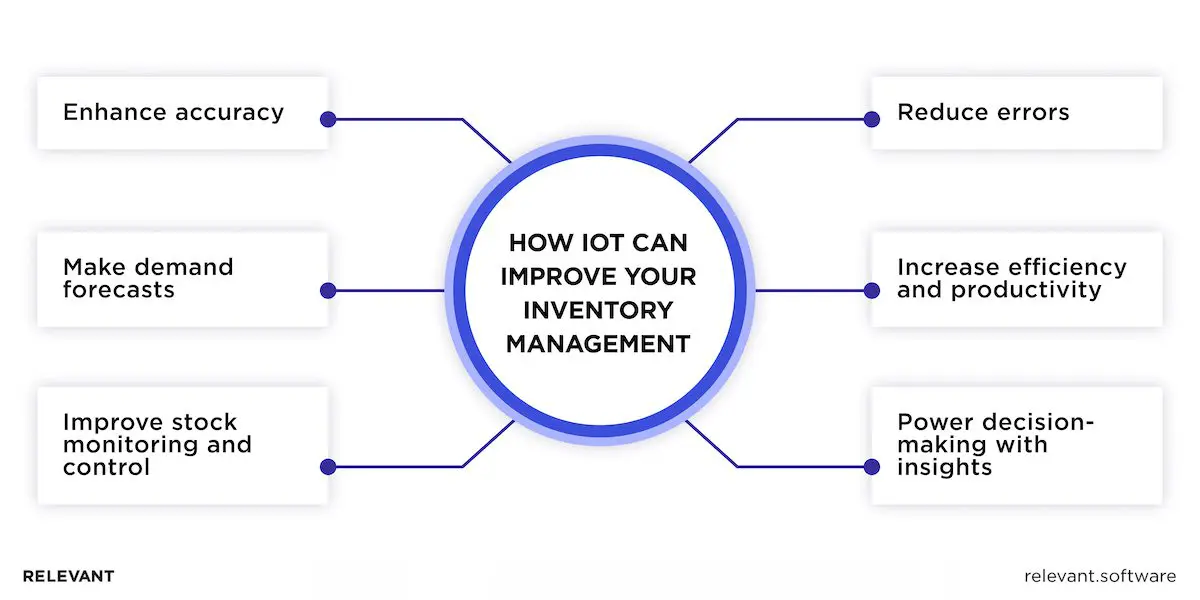
Enhanced Accuracy and Reduced Errors
Managing inventory is a delicate task that requires maintaining enough stock to satisfy demand and avoiding costly overstocking. Many warehouses struggle to control their inventory accurately due to a lack of visibility and human mistakes. Misplaced items or misread labels can disrupt the flow of goods, create significant financial headaches, and ultimately result in poor customer service.
IoT device inventory system gives you an incredible level of accuracy. With IoT in inventory management, a simple scan with a mobile app can pinpoint the location of any tagged item. No lost inventory, and the information on each item is always up-to-date and accurate.
Let’s imagine a pharmaceutical distributor plagued by manual errors in their warehouse, with misplaced medications and delays in order fulfillment being the main constraints. Implementing inventory management IoT solutions equipped with RFID tags and smart sensors can yield impressive results for the company:
- Error rates are reduced by half or more. Automated tracking with RFID tags reduces the cases of misplaced medications and misread labels.
- Order fulfillment time cut in half. Real-time data on inventory location allows for faster picking and packing of orders.
- Improved product quality. Temperature sensors ensure optimal storage conditions for sensitive medications.
Improved Stock Monitoring and Control
Thanks to RFID and Internet of Things technology, inventory managers can now escape the tedious task of manual tracking. Every item is easily monitored, and information about it is automatically captured and sent to your central system. Automation of manual data entry and similar routine tasks can save hours of work while incredibly reducing the risk of human error or duplicated data.

With an IoT management system, you don’t need to play inventory roulette. Smart sensors can detect when stock levels fall below a certain threshold and immediately trigger reorder processes. No more frantic, last-minute rushes to restock shelves or accepting out-of-stock situations. Your inventory is always at the optimal level, which is the foundation for hassle-free operations and customer satisfaction.
One more seemingly simple yet so helpful functionality is stock alerts. The smart inventory system can notify you of potential issues, such as low-selling items that are near expiry or unexpected spikes in demand for specific products. This allows you to adjust and keep your inventory at optimal levels.
Increased Efficiency and Productivity
Warehouse workers spending hours searching for misplaced items instead of fulfilling orders is a symptom of the time-intensive tasks and inadequate internal processes that have plagued traditional inventory management. In addition to time waste, it also strains your resources. How is IoT used in inventory management to drive productivity?
First of all, the IoT solution replaces manual work with automation. RFID tags and sensors that capture information on products eliminate the need for manual barcode scanning or inventory movement tracking. When your staff doesn’t have to deal with repetitive, mundane tasks and gets involved in more meaningful activities, their morale and productivity will naturally increase. Happier, more engaged employees are the basis of successful business.
With real-time data and predictive analytics enabled by IoT in inventory management, you can see exactly how many of each item you have at any given moment. Such visibility lets you optimize stock allocation across your warehouse and place items into the most logical and accessible locations. For instance, you can identify slow-moving inventory and clear out stagnant stock to free up storage space for faster-selling items.
Better Decision-Making and Forecasting
Stock control used to be a guessing game where historical data often led to stockouts, excess inventory, and, ultimately, lost profits. A smoothly operated warehouse depends on the right decisions made timely and based on up-to-date information. IoT device inventory helps with it.
IoT devices collect information on stock movement, sales trends, and environmental factors, which are then analyzed to glean insights into your inventory operations. You can see which products are flying off the shelves and which gather dust to make smarter decisions about what to stock and where to allocate resources.
Traditional inventory management methods use historical data for demand forecasting, and the beauty of IoT inventory management is that it leverages real-time data collected from sensors and connected devices. Up-to-the-minute information on customer preferences, market trends, and inventory levels allows for more precise predictions and improved decision-making. For instance, if your system detects a sudden spike in demand for a particular item, it lets you know immediately so you can adjust your inventory levels before it becomes a problem.
Steps to Implement IoT Inventory Management Solutions
If you are intrigued by the capabilities of IoT in inventory management and plan to adopt this advantageous technology as painlessly as possible, we outline the essential steps to get you started.

1. Identify Specific Problems to Solve with IoT
The first step you should take is to diagnose the problem you want IoT in inventory management to address. Do you often face stockouts due to inaccurate inventory data? Does inefficient asset tracking cause delays in your operations? Make clear the pain points you aim to resolve. That’s the right approach that will ensure the IoT solution you implement directly impacts your business goals. For example, if the issue lies in inefficient energy consumption, deploying smart sensors to monitor usage patterns would be a more targeted approach compared to a broad implementation across your entire system.
2. Assess Infrastructure and Resource Requirements
Conduct a thorough infrastructure assessment, as it’s the foundation upon which your IoT in inventory management solution will be built. First of all, you should evaluate your current network bandwidth, enough data storage capacity, and security protocols. Can your network handle the influx of data from connected devices? Do you have specialists in-house with the expertise needed to manage the data collected by the IoT management system and control IoT devices? Understanding these limitations upfront will help you with strategic planning for upgrades or additional resources required for seamless integration.
3. Choose the Right IoT Technologies and Vendors
The diversity of IoT technologies and a huge number of vendors can overwhelm everyone who is not well-versed in the tech landscape. Look for options that meet your specific needs and budget. When selecting an IoT device inventory solution, consider factors like the scalability to accommodate future growth, as well as the security features offered by the vendor. As for the vendor selection, don’t just go for the biggest name. Hire IoT developers with expertise in custom solutions tailored to your industry, experience integrating IoT systems, and a proven track record of reliability and support.
4. Design the IoT Solution
The system architecture is the blueprint of your solution. It defines the hardware components needed (sensors, RFID tags, gateways), the communication protocols (Wi-Fi, Bluetooth), and the data management platform where information will be collected and analyzed. Security considerations like access control and IoT device security are also crucial aspects of this design phase.
Accurate data is the lifeblood of your Internet of Things inventory management system, but it needs to be properly managed and protected. So, it’s of paramount importance to define clear protocols for data collection, storage, and analysis. The creation of an IoT dashboard that is easy to use is also a critical element that will help you visualize data. Make sure your platform has secure data encryption and access controls to safeguard sensitive information.
5. Develop and Test a Prototype
Building a proof-of-concept is an excellent way to test the functionality of your solution before full-scale deployment. Whether a high-fidelity or simpler prototype, it lets you discover potential issues at early stages and refine your design to avoid costly adjustments later on.
6. Gather Feedback and Make Adjustments
End users of inventory management IoT systems should be the main judges of the solution you build. So, get your warehouse employees involved in the prototype testing phase as well. Their opinion on how well the software meets their needs and how intuitive the user interface is is absolutely crucial. Listen to their suggestions and make necessary adjustments to the design.
7. Full-Scale Deployment
The rollout of the IoT solution across your organization is the next big step. Plan this carefully to minimize disruption to your existing operations. Here are some tips and strategies our experts usually follow:
- Phased implementation. System rollout in stages, starting with a small section of your operations, is a great way to test the waters. By deploying the system in a controlled environment, you can detect and fix any unforeseen challenges before they impact entire operations.
- Communication. Transparency and clear communication about the changes awaiting employees due to the adoption of IoT in inventory management is important. You can organize town hall meetings or internal communication channels to explain the significant benefits of the new system and address any concerns employees may have.
- Training and support. Ensure that all warehouse staff members are trained on how to use the new system effectively. Hands-on sessions and ongoing support will help employees quickly get used to new processes and feel confident using the system.
8. Monitor and Maintain
The active phase of system development and deployment is finished, but it isn’t the end. Maintaining software is similar to managing a building. Regular inspections, repairs, and upgrades are inevitable to keep the building safe and up to code. Similarly, software needs periodic updates to fix issues, improve features, and ensure compatibility with new technologies.
That’s why you should continuously monitor the system’s performance and address any issues, as well as establish a proper maintenance routine to ensure the sensors, devices, and the whole system function optimally. These tasks can be easily outsourced or performed by the IoT development company you collaborate with.
9. Analyze ROI and Identify Areas for Improvement
Now, it’s time to quantify the value you’re getting from your investment. The initial analysis in the post-deployment window (3-6 months) allows you to assess the immediate impact of the system on key metrics and serve as a baseline for future comparisons. The list of key metrics includes but not limited to:
- Inventory Accuracy. Has the system reduced stockouts and misplaced inventory items?
- Order Accuracy and Fulfillment Times. Are orders being picked, packed, and shipped faster?
- Warehouse Efficiency. Has overall warehouse productivity improved?
- Labor Costs. Are there any labor savings due to automation and streamlined processes?
Using these metrics, you can calculate the Return on Investment (ROI) of your project and see the real value of your investment.
10. Plan for Future Expansion and Upgrades
Here are some proven tactics to future-proof your IoT-powered system:
- Stay updated on technology trends. Keep yourself informed about the latest advancements in sensors, data management platforms, and analytics tools.
- Plan for scalability. Design your system with scalability in mind so that you can easily accommodate future growth in your inventory or warehouse space.
- Schedule regular upgrades. Don’t wait for your system to become outdated. Plan for regular upgrades to incorporate new technologies and ensure your system remains secure and efficient.
Challenges and Considerations of IoT Implementation
IoT inventory management facilitates a number of operations simply by delivering sufficient information on inventory levels. Outdated systems replaced with IoT devices improve your tracking capabilities, item traceability, and quality control. Yet, the way to these benefits is filled with certain challenges that companies should be aware of to overcome them with confidence.
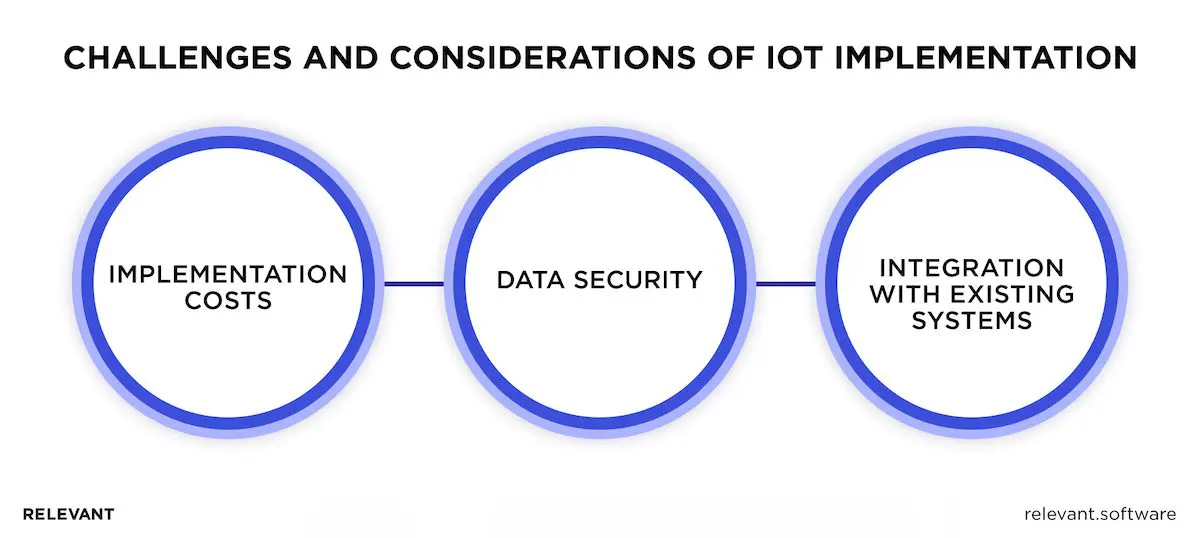
Implementation Costs
Internet of Things adoption is a substantial investment that requires careful budgeting. The initial costs can be hefty, as you need to purchase sensors and devices and perhaps upgrade your infrastructure to support the increased data flow. Software platforms, staff training, and potential new hires with the necessary expertise can also add to the expenses. The upfront investment is indeed high, but the ROI from improved supply chain efficiency and better decision-making will pay off the initial expenditure.
Data Security
IoT devices generate vast amounts of data, much of which is sensitive and, therefore, requires even stronger protection. Each implemented sensor, and the device is a point of data transmission that hackers may exploit. Securing the IoT system may sound like a very difficult task, yet it is not insurmountable. What you need is to follow some best security practices:
- Data encryption. Ensure all data transmission and storage are encrypted to safeguard sensitive information from unauthorized access.
- Device security. Implement robust security protocols on your IoT devices to prevent hacking and malware attacks.
- Access control. Establish clear access control measures to restrict who can access and modify data within the system.
If you are not sure about the level of your system protection, turn to relevant cybersecurity specialists to help you boost security.
Integration with Existing Systems
Integrating an IoT system with your current infrastructure, such as warehouse management systems (WMS) or enterprise resource planning (ERP) systems, can be challenging. Your challenge is even deeper if you use outdated, legacy systems that weren’t designed with IoT in mind. That’s why making them work together seamlessly can feel like fitting a square peg into a round hole. Different data formats and communication protocols will also create incompatibility issues.
To address this, there are several strategies you can employ:
- Standardized protocols. Whenever possible, choose devices and platforms that adhere to industry-standard communication protocols.
- API integration. Use Application Programming Interfaces (APIs) to enable smooth data exchange between the IoT system and existing software.
- Professional integration services. Partner with experienced IT professionals skilled in integrating Internet of Things systems with legacy infrastructure.
Our IoT Case Studies
Here are a couple of our clients’ success stories and what they have gained with the Internet of Things implementation.
Platform for remote sensor management
Sensor Innovation approached us with a promising product – a hardware sensor system combined with software algorithms to detect and prevent water leaks in residential and industrial settings. However, their existing platform lacked an intuitive user interface and efficient workflows. They needed to:
- Revamp UI/UX to simplify sensor management.
- Enhance functionality with new features like a virtual building map for sensor visualization.
- Streamline data analysis and reporting for better decision-making.

We completely redesigned the UI and UX of their platform. Our team created a dashboard for user and device management that is easier to navigate. A virtual building map now displays sensor locations and status, which optimizes sensor placement. Also, we implemented a feature that allowed our client to decrease the number of false positives due to the analysis of sensor data alongside weather information. The revamped platform surpasses its iteration in all metrics, including user experience and overall performance.
Web dashboard creation for sensor data visualization
AirThings, a leading Norwegian tech company with a focus on indoor radon monitoring since 2008, approached us with a challenge. While they had a custom dashboard displaying air quality data from their devices, it lacked the real-time functionality and scalability needed for their growing user base. So, our client needed:
- Visualization of real-time air quality data from their devices globally – for both end-users and AirThings managers.
- Large-scale map optimization to avoid lag during transitions.
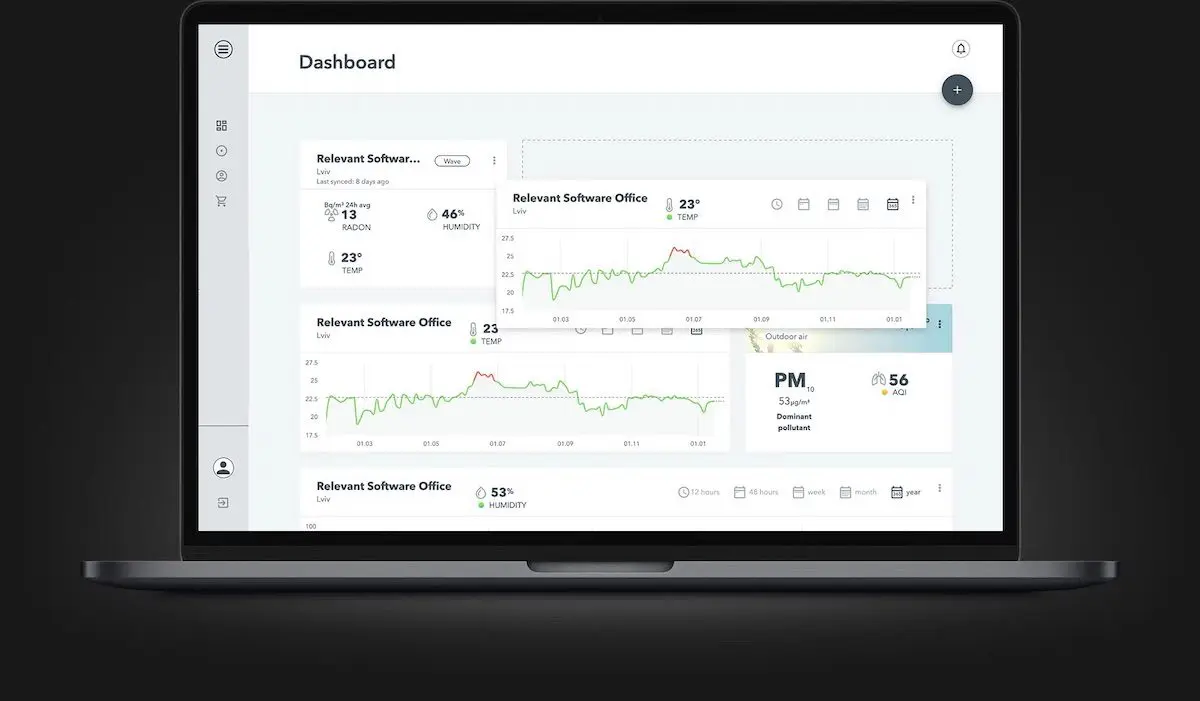
We built a new dashboard that connects IoT devices and offers a customizable view with easy drag-and-drop tiles and data export options. To ensure smooth navigation with a large number of devices, we optimized the map’s loading times through multi-domain downloading and reduced lag during transitions with server-side rendering. A new, more convenient platform allowed our client to attract more users and more easily track their devices distributed globally.
IoT in Inventory Management: Bottomline
Inventory management is being transformed by the Internet of Things every day with increased intelligence and efficiencies. It lets businesses, especially those in the cutthroat world of eCommerce, boost efficiency and gain a strategic edge. Thanks to real-time data visibility and automated processes, IoT in inventory management changes it from a logistical headache into a value driver. Nobody wants to be left behind. That’s why IoT is such a popular technology nowadays.
If you’re tired of stockouts and inaccurate inventory counts, Relevant Software can help. We have the experience to develop inventory asset management software solutions that will upgrade your inventory management and unlock the power of real-time data. Contact us and tell us about your inventory challenges.



